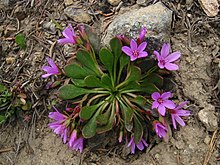Claytonia megarhiza
| Claytonia megarhiza | |
|---|---|

| |
| In the Wenatchee Mountains | |
| Scientific classification | |
| Kingdom: | Plantae |
| Clade: | Tracheophytes |
| Clade: | Angiosperms |
| Clade: | Eudicots |
| Order: | Caryophyllales |
| Family: | Montiaceae |
| Genus: | Claytonia |
| Species: | C. megarhiza
|
| Binomial name | |
| Claytonia megarhiza | |
Claytonia megarhiza is a species of wildflower in the family Montiaceae known by the common names fell-fields claytonia[1] and alpine springbeauty.[2] It is native to western North America from northwestern Canada to New Mexico, where it grows in rock crevices and talus habitats in subalpine and alpine climates. The species is known from summits and slopes of North America's highest mountains including the Redstone Mountains of the Canadian Northwest Territories, disjunct south to the central and southern Rocky Mountains reaching a southern limit in the Sangre de Cristo Mountains.[3] The specific epithet megarhiza is Greek for "large roots".[2]
This is a perennial herb growing from a thick, scaly caudex topped with a stem 5–25 cm (2–10 in) in length.[1] The fleshy basal leaves form a dense rosette around the caudex. The leaves are red when young and turn green as they slowly produce chlorophyll.[2] The inflorescence appears within the patch of leaves. It is a dense cluster of two to six white or pinkish flowers.[4] Each petals reaches 5–20 mm (0.2–0.8 in) in length.[1]
The rosettes of the leaves and the roots can be eaten as an emergency food.[5]
References[]
- ^ a b c Flora North America
- ^ a b c Southwest Colorado Wildflowers
- ^ Miller, J. M. and K. L. Chambers. 2006. Systematics of Claytonia (Portulacaceae). Systematic Botany Monographs 78: 1-236. ISBN 0-912861-78-9
- ^ Jepson Manual Treatment
- ^ Elias, Thomas S.; Dykeman, Peter A. (2009) [1982]. Edible Wild Plants: A North American Field Guide to Over 200 Natural Foods. New York: Sterling. p. 92. ISBN 978-1-4027-6715-9. OCLC 244766414.
External links[]
 Media related to Claytonia megarhiza at Wikimedia Commons
Media related to Claytonia megarhiza at Wikimedia Commons- Photo gallery at CalPhotos
- Claytonia
- Plants described in 1862
- Flora of North America